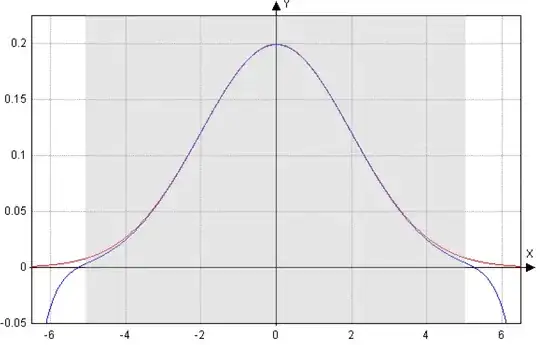The background has a close practical reference to (computer aided) 3D visualization techniques. It is about "melting" spheres using so-called Blinn objects (shortly "Blobs"):
For this we need a Gaussian function $g(q)=\frac{1}{\sigma\sqrt{2\pi}}e^{\frac{-|q-c|^2}{2\sigma^2}}$, $q,c\in\mathbb{R}^3,\sigma\in\mathbb{R}^+$. The Blobs are given by the set: $B_g=\{q\in\mathbb{R}^3|g_{\sigma,c}(q)=k\}$. The variable $c$ is the center of a Blob. Varying $\sigma$ adjusts the radius of a Blob. Composing these Blobs leads to a "Blobby Surface" in which the Blobs $B_i$ are melted together. For this we use the implicit functions $g_i$ and constants $k_i$:
$$ f(q)=-k+\sum_{i=1}^ng_i(q)~~\text{where}~~k=\sum_{i=1}^nk_i $$
The challenge is to replace the Gaussian function by a polynom to make calculations more efficient. This can be done by approximating $g$ using a polynomial $p(x)=a_0+a_2x^2+a_4x^4+\ldots+a_{2n}x^{2n}$, where we set $p(0)=g(0)=a_0$ and $\frac{\partial}{\partial x}p(x)=\frac{\partial}{\partial x}g(x)$ for $x_1=t,x_2=2t,\ldots,x_n=nt$, $t\in\mathbb{R}^+$.
The question is: Using Vandermonde (or some similar tricks), can we simplify the resulting matrix equation that solves the coefficients of our polynomial:
$$ \begin{pmatrix} a_2\\ a_4\\ \vdots\\ a_{2n} \end{pmatrix} = \begin{pmatrix} 2\cdot(1t) & 4\cdot(1t)^3 & \cdots & 2n\cdot(1t)^{2n-1}\\ 2\cdot(2t) & 4\cdot(2t)^3 & \cdots & 2n\cdot(2t)^{2n-1}\\ \vdots & \vdots & \ddots & \vdots \\ 2\cdot(nt) & 4\cdot(nt)^3 & \cdots & 2n\cdot(nt)^{2n-1}& \end{pmatrix} \begin{pmatrix} g'(1t)\\ g'(2t)\\ \vdots\\ g'(nt) \end{pmatrix} $$
I see that the matrix structure looks a little bit like it would allow simplification using Vandermonde. Maybe there exist some tricks that enable us to benefit from Vandermonde.
For those who are interested in the approximation result (in 3D): The original "Blobby Surface" is depicted on the left and the approximated surface on the right:
$\require{HTML} \newcommand{\mypic}[4][]{ \style{ display: inline-block; background: url(https://i.stack.imgur.com/#4) no-repeat center; #1 }{\phantom{\Rule{#2}{#3}{0px}}}}$
$$\begin{array}{cc} \mypic{280px}{300px}{4lD4xm.png}& \mypic{280px}{300px}{cmNLWm.png} \end{array}$$
The approximation of the Gaussian curve (red) by the polynomial (blue) looks as follows:

